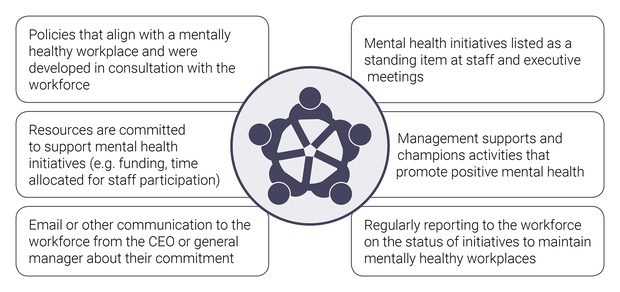On 31 March 2022, the Work Health and Safety (WHS) laws replaced the health and safety elements of the Mines Safety and Inspection laws. For information visit www.demirs.wa.gov.au/whs
All health and safety notifications, forms and guidance for mining and petroleum has moved to the WorkSafe website
The information below has been left for historical compliance reference purposes

Demonstrating commitment

Building and maintaining a mentally healthy workplace requires a multi-tiered, team approach that begins with leadership commitment. Senior management and organisational leaders play a critical role in positively influencing workplace culture, management practices and the experiences of their workforce. Their involvement signals the importance of being safe at work and encourages workers to engage in positive practices.
Some strategies to motivate organisational leaders to commit to a mentally healthy workplace include:
- presenting case studies that demonstrate what other organisations are doing or have done, and what has worked for them. Refer to Heads Up – Case studies for case studies ranging from personal stories to organisational strategies for change
- building a business case for a mentally healthy workplace, keeping the interests of your workplace in mind. For guidance in building a business case, refer to Thrive at Work – Construct a business case
- demonstrating the return on investment of a mentally healthy workplace using the Heads Up return on investment tool.
It is important that leadership commitment is visible to the workforce. This graphic highlights some examples of visible commitment.
What’s next?
Like most things worth doing, developing and maintaining a mentally healthy workplace requires planning and target setting. It is important to note there is no one approach that fits all – each organisation should have a strategy that takes into account the size, location, organisational structure and specific issues faced. Having documented policies and procedures formalises the organisation’s commitment to mental health and wellbeing and contributes to an effective safety culture.
It is also important to consider where your organisation sits on the safety and health culture spectrum, and use this knowledge to guide your organisation's next steps in developing a mentally healthy workplace.
Resources
|
To assist develop or update your workplace’s mental health and wellbeing policy, the following resources are available |
|
|
This website by HeadsUp contains resources for leaders to create mentally healthy workplaces. It comes from a position which states that workplace health is a leadership issue and change must start at the top in order to positively influence workplace culture, management practices and the experience of workers. |
|
|
This website by the UK Health and Safety Executive contains leadership guidance for all boards, directors and senior executives. It has sections on setting the direction, introducing management systems and practices, monitoring and reporting and reviewing performance. |
|
|
Leadership for the Major Hazard Industries: Effective Safety and Health Management |
This booklet by the UK Health and Safety Executive is designed to help industry leaders further improve the health and safety performance of all major hazard industries, both on and offshore. It looks at key leadership issues in achieving a health and safety culture, leading by example, having effective systems and an engaged workforce. |
|
This toolkit by the UK Health and Safety Executive focuses on health and safety leadership in construction industries. It has information and resources for leaders, managers and workers. It helps companies understand their risk profile and engage their workers in a positive health and safety culture. |
|
|
This pack by WorkSafe QLD contains tools and information to help you identify what you need to do to make your workplace safer and outlines how to do it. Advice Sheet 1 focuses on management commitment. |
